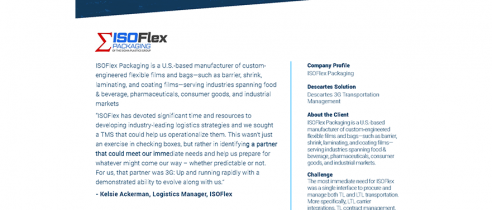As sustainability in the shipping and transportation industries continues to become more prominent, taking initiative to track carbon emissions is no longer just a preference, but a necessity. At 3G, we’ve been surprised by the influx of customer requests for green shipping, greenhouse gas (GHG) emissions tracking, and other eco-friendly reporting features. More and more, companies are being required to integrate comprehensive sustainability into their operations, transforming what was once a ‘nice-to-have’ feature into a mandatory part of business.
This new reality marks a pivotal change, underscoring the urgency and importance of aligning with national zero-emissions goals in freight. After decades of talk, sustainability and carbon reduction efforts are sweeping through the transportation sector whether stakeholders like it or not. The question is: What does it take to contribute to the mission? And more importantly: Are you doing your part?
Understanding Transportation Emissions Goals
In April, the U.S. adopted an agenda to reduce carbon emissions throughout the shipping and freight industries to zero, part of a larger net-zero emissions goal for the entire economy targeted for 2050. Other laws are also requiring companies that generate over $1 billion in revenue each year to report the carbon emissions throughout their supply chain on an annual basis.
Over time, these requirements will expand to other high-revenue companies, and eventually mandate meeting specific GHG emission reduction targets, with a substantial impact on overall carbon emissions from every sector affected. These green shipping goals are critical to reaching any kind of sustainability or climate change mitigation goals because reducing carbon:
- Combats global warming — the cause of increasing extreme weather events and climate change.
- Improves overall economic efficiency for companies and industries that practice sustainability.
- Cuts pollution, improving the environment and quality of life for people throughout a region.
- Protects public health by minimizing people’s exposure to toxins, as well as reduces the economic burden of illness outbreaks on a populace.
The Road to Net-Zero Emissions
The newest legislation and policies are foundational, setting mandates for in-depth reporting. But even if these regulations aren’t impacting you yet, it’s critical to adopt GHG emission tracking processes voluntarily, not only to stay ahead of the curve in terms of regulations, but also to start doing your part for carbon reduction as soon as possible.
You can begin by investing in software that enables greenhouse gas emission reporting throughout your supply chain. This kind of software is essential to complying with reporting requirements and can help provide you with the operational insight into how to reduce emissions when you’re ready.
From there, the efforts to improve operational efficiency and reduce costs can become part of your carbon emissions reduction strategies:
1. Supply Chain and Logistics Optimization
Following more efficient protocols, like route optimization, allows you to design more sustainable transport routes that minimize travel distances and reduce fuel consumption, automatically lowering carbon emissions throughout your operation. Load optimization strategies are also key for fitting more products safely into containers, reducing the total number of shipments needed to transport goods. This doesn’t just cut down on direct emissions — it also decreases traffic congestion and allows other vehicles on the road to travel less distance and improve fuel efficiency as well.
2. Diversify Shipping Modes
Utilizing intermodal transport is another key strategy for reducing GHG emissions. It takes advantage of the strengths of each transportation mode, especially over long distances where rail or water transport can be much more efficient than road or air transport. In addition to reducing overall shipping costs and often enabling faster delivery, intermodal is becoming an increasingly effective way to lower your carbon footprint — especially as it becomes more robust amid increasing industry demand.
3. Improve GHG Emission Visibility
Refining elements of your operation like carrier selection processes and coordination processes allows you to identify and utilize more eco-friendly vendors. For example, including sustainability metrics in the way you rank carrier performance can help you easily choose more eco-friendly carriers without losing any efficiency during the selection process. You can reduce carbon emissions by sheer virtue of who you decide to work with, not to mention amplify GHG emissions reduction through both of your companies’ efforts.
4. Integrating Renewable Energy
Installing solar panels or other renewable energy generators at your facilities allows you to generate your own clean energy, not only reducing energy costs, but also cutting reliance on fossil fuels and lowering your carbon footprint. In lieu of direct facility upgrades, it is increasingly common to source from renewable energy suppliers, powering your warehouse and offices with green energy without any upfront investment. This helps in achieving GHG emission reduction targets, stabilizes energy costs, and enhances your company’s sustainability credentials in the market.
Navigating the Journey to Zero Emission Shipping, Together
Currently, the U.S. transportation industry accounts for 28% of the nation’s yearly greenhouse gas emissions. Achieving zero emissions will require a national effort. But fortunately, it’s already well underway.
To contribute to the movement, you need a transportation technology platform that helps you not only improve sustainability, but also track metrics and maintain transparency. 3G has emerged as one of the few software providers that offers greenhouse gas emissions reporting capabilities. It’s quickly becoming a tool that allows users to simultaneously streamline operations and track carbon emissions in a single, unified platform, elevating carbon reduction strategies to the same level as business optimization strategies.
3G has helped customers like Green Circle Growers improve efficiency and conserve fuel, saving over 288 loads and approximately $520,000 in savings. We’ve also helped AmerCareRoyal improve efficiency so much they’ve removed the equivalent of 110 trucks from the road each year — reducing greenhouse gas emissions by 22 million kilograms.
Want to make sure you’re doing everything you can to reduce GHG emissions? Learn more about green shipping practices here.








